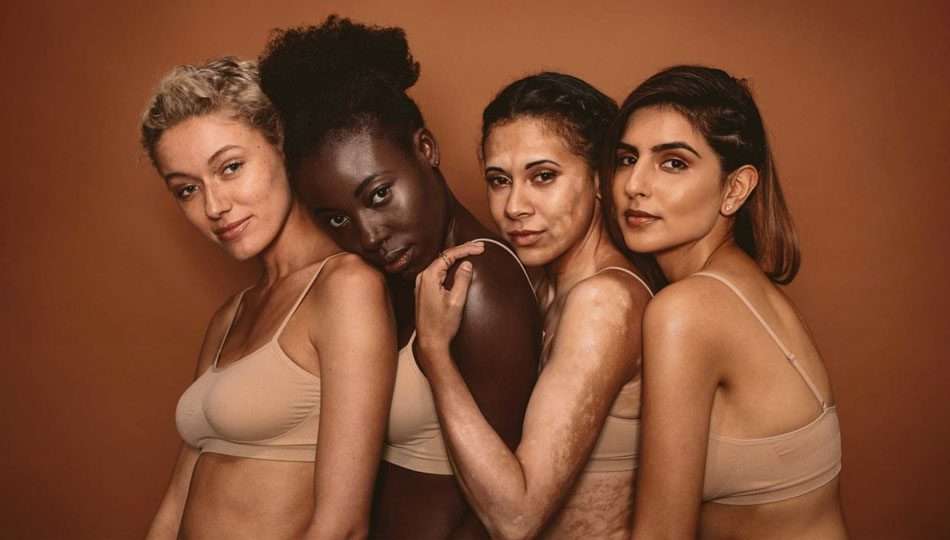
No matter your prevention strategies, aging is an inevitable and complex process that can be described clinically as features of wrinkles, volume loss, pigment changes, drynesss, dark spots, uneven skin color, and sagging skin. These cutaneous effects are influenced by both intrinsic and extrinsic factors and often are varied based on ethnic origin given underlying structural and functional differences. The authors sought to provide updated information on facets of aging and how it relates to ethnic variation given innate differences in skin structure and function. Publications describing structural and functional principles of ethnic and aging skin were primarily found through a PubMed literature search and supplemented with a review of textbook chapters. The most common signs of skin aging despite skin type are dark spots, loss of elasticity, loss of volume, and rhytides. Skin of color has many characteristics that make its aging process unique. Those of Asian, Hispanic, and African American descent have distinct facial structures. Differences in the concentration of epidermal melanin makes darkly pigmented persons more vulnerable to dyspigmentation, while a thicker and more compact dermis makes facial lines less noticeable. Ethnic skin comprises a large portion of the world population. Therefore, it is important to understand the unique structural and functional differences among ethnicities to adequately treat the signs of aging.
“We’re all aging, despite the times there’s bone remodeling and fat redistribution that’s happening in our 20s.”
But, what aging looks like, which signs of Father Time your skin will show, and when you’ll start to look older aren’t so universal. Aging skin and when it starts to show depends on both extrinsic factors (whether or not you smoke, how religious you are about sunscreen) and intrinsic ones like genetics or ethnicity.
Aging skin can be particularly unique for men or women of different ethnicities.
Generally, signs of aging occur later and are less pronounced in ethnic skin. Our original skin contains pigment-producing cells called melanocytes. Everybody has the same number of melanocytes, but the cells can produce different kinds of pigments [called melanin] in the skin.
Caucasian people make lighter pigments; black people make darker ones. This plays a role in sun protection, she says. Research finds, for example, that Caucasian skin has an SPF of about 3.4. Black skin is protected with a “natural” SPF of 13.4.
In darker-skinned populations, other signs of aging such as wrinkles (particularly those super fine ones around the eyes and lips) tend to be delayed by anywhere from 10 to 20 years. But, it can also be more susceptible to certain age-related issues such hyperpigmentation (dark spots), hypopigmentation (light spots) and more.
So, what can you expect to see in years to come depending on your DNA? Here, experts weigh in. …

Time’s Effects on Ethnic Skin
When it comes to African-American or Afro-Caribbean skin, higher amounts of melanin could bring an increased risk of brown spots, uneven skin tone, and a benign condition called dermatosis papulosa nigra, small dark spots that develop on your face.
African-American patients often complain of volume loss and redistribution. Due to differences in facial structure, this can be more common in your eyes and mid face.
Asians can suffer from deeper skin wrinkles around the forehead and sagging around the jawline and eye areas. Melasma is another biggie, featuring gray-brown patches on sun-exposed areas and sun spots.
A benign condition called seborrheic keratoses — waxy, dark-colored elevated spots on the skin — can strike this population, too, she explains.
In general, ethnic skin tends to be drier than Caucasian skin, but Hispanic skin is usually oilier. One might also suffer from melasma or pigmentation issues due to cells making pigments in high amounts when exposed to sun or hormones.
As we age, our skin undergoes significant changes, and this is especially true for those with ethnic backgrounds. Ethnic skin often has unique needs and requires a tailored approach to maintain a youthful, radiant appearance. In your 40s, 50s, and 60s, it’s crucial to adopt a skincare routine that addresses the specific concerns of aging ethnic skin.
One of the key factors to consider is the increased susceptibility of ethnic skin to hyperpigmentation and uneven skin tone. A comprehensive anti-aging protocol should include brightening and corrective ingredients to address these concerns. Look for products containing vitamin C, retinoids, and niacinamide to help even out your complexion and minimize the appearance of age spots and discoloration.
Equally important is maintaining a robust moisture barrier as your skin matures. Opt for hydrating, nourishing formulas that replenish the skin’s natural oils and prevent premature dryness and wrinkle formation. Incorporating a potent, yet gentle, retinol serum can also stimulate collagen production and improve skin elasticity.
By tailoring your skincare routine to the unique needs of aging ethnic skin, you can achieve your best complexion yet, radiating confidence and youthfulness well into your 40s, 50s, and beyond.
—
As we age, our skin undergoes significant changes, and this is especially true for those with ethnic backgrounds. Ethnic skin has unique characteristics that require specialized care to maintain a youthful, radiant appearance. In your 40s, 50s, and 60s, it’s crucial to adapt your skincare routine to address the specific needs of aging ethnic skin.
One of the key differences in ethnic skin is the higher melanin content, which can lead to increased sensitivity and a higher risk of hyperpigmentation. To combat this, it’s essential to incorporate brightening and even-toning ingredients into your routine, such as vitamin C, niacinamide, and retinoids. These powerful actives can help reduce the appearance of age spots and uneven skin tone.
Additionally, ethnic skin tends to be drier and more prone to dehydration as we age. Incorporating hydrating and nourishing ingredients, like hyaluronic acid, ceramides, and plant-based oils, can help maintain the skin’s natural barrier and prevent premature aging.
Remember, the best anti-aging skincare routine for women over 50 with ethnic skin is one that addresses your unique concerns and provides the necessary nourishment and protection. By following a tailored protocol, you can achieve your best skin yet, radiating confidence and youthfulness in your 40s, 50s, and beyond.
—
As we age, our skin undergoes significant changes, and these changes can be even more pronounced for those with ethnic skin tones. Navigating the world of skincare can be challenging, but with the right knowledge and approach, you can have your best skin yet, even in your 40s, 50s, and beyond.
One of the key differences in aging ethnic skin is the way melanin, the pigment that gives our skin its color, behaves over time. Ethnic skin tends to be more prone to discoloration, uneven tone, and age spots. That’s why it’s crucial to incorporate targeted treatments that address these concerns, such as brightening serums and broad-spectrum sunscreen.
Moreover, the natural aging process can lead to a loss of elasticity and the appearance of fine lines and wrinkles. To combat this, look for skincare products that contain retinoids, which can stimulate collagen production and improve skin texture. Pair this with hydrating ingredients like hyaluronic acid to maintain a youthful, plump appearance.
Establishing a consistent, tailored skincare routine is key to achieving your best skin as you age. The right combination of cleansers, serums, moisturizers, and treatments can help you address your unique concerns and maintain a radiant, healthy complexion well into your golden years.
